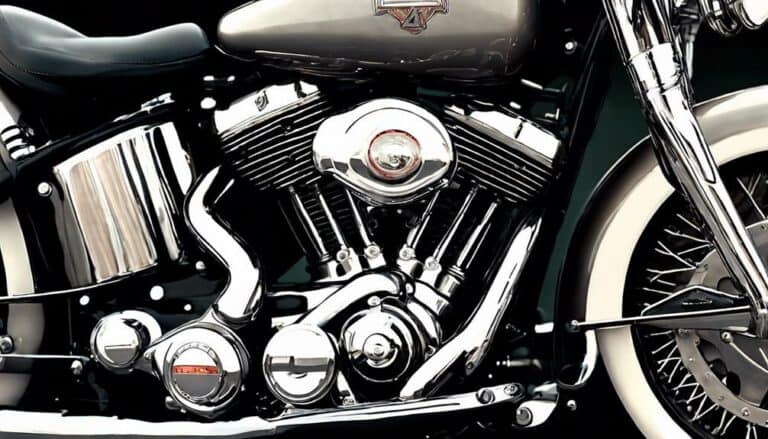If you were to compare the engine on a 1953 Harley Davidson Servi-Car to a reliable workhorse, you'd be quite accurate.
The engine that powers this iconic three-wheeled vehicle holds a significant place in Harley-Davidson's history. Understanding the intricacies of this engine not only sheds light on the Servi-Car's performance but also offers a glimpse into the innovative engineering prowess of that era.
Curiosity might lead you to discover how this engine impacted the Servi-Car's functionality and why it remains a topic of interest for motorcycle enthusiasts and historians alike.
Key Takeaways
- 45 cubic inch V2 flathead engine with 24.0 HP at 4400 RPM.
- Sidevalve fuel control system for efficiency and power delivery.
- Bore x stroke of 70.0 x 97.0 mm for optimal performance.
- Top speed of approximately 101.0 km/h (62.8 mph) for thrilling rides.
Engine Specifications of 1953 Servi Car
The 1953 Servi Car's engine specifications reveal a powerful 45 cubic inch flathead engine that delivers approximately 24.0 HP at 4400 RPM with V2, four-stroke configuration, and sidevalve fuel control. This robust engine design on the Harley-Davidson Servi-Car was a game-changer, offering riders a thrilling experience on the road.
With a bore x stroke of 70.0 x 97.0 mm (2.8 x 3.8 inches), this beast of an engine packed a punch, propelling the Servi-Car to a top speed of around 101.0 km/h (62.8 mph). The engineering excellence of this machine not only provided power but also guaranteed a smooth and efficient ride.
Riders looking for liberation on the open road found solace in the reliable and performance-driven engine of the 1953 Servi Car. Owning a Harley-Davidson Servi-Car meant having the strength and agility to conquer any journey, making it a symbol of freedom and empowerment on wheels.
Evolution of Harley-Davidson Servi Car Engine
Initially introduced in the late 1930s, the engine of the Harley-Davidson Servi Car underwent a significant transformation from its original solo R model to the more advanced W model. These evolutionary changes marked a shift towards improved performance and reliability, showcasing the brand's commitment to mechanical advancements. The historical significance of this shift lies in the enhanced power output and overall efficiency of the engine, catering to the growing demands of riders seeking a dependable and robust vehicle.
The change from the solo R model to the W model brought about notable upgrades in fuel control and power delivery, setting the stage for a new era in Harley-Davidson engineering. These advancements not only enhanced the riding experience but also solidified the Servi Car's reputation as a versatile and durable workhorse. Through meticulous design and innovation, Harley-Davidson succeeded in elevating the performance capabilities of the Servi Car engine, cementing its status as a trailblazer in the world of three-wheeled motorcycles.
Performance Features of 1953 Engine
Marking a notable advancement from its predecessor, the 1953 Harley-Davidson Servi-Car engine showcases impressive performance features that embody the brand's dedication to power and reliability. This V2, four-stroke engine with a 45 cubic inch displacement delivers a power output of 24.0 HP (17.5kW) at 4400 RPM, ensuring a thrilling ride.
The reliability factor is enhanced by the sidevalve fuel control system and the engine's bore x stroke of 70.0 x 97.0 mm (2.8 x 3.8 inches), offering a balance between power and durability. When it comes to speed capabilities, this engine doesn't disappoint, reaching a top speed of 101.0 km/h (62.8 mph).
Whether you're using it for commercial purposes or cruising around town, the 1953 engine on the Servi-Car provides the classic Harley-Davidson performance that enthusiasts crave. Get ready to experience a blend of power, reliability, and speed that defines the essence of Harley-Davidson engineering.
Technological Details of 1953 Engine
Revealing the intricate technological components of the 1953 Harley-Davidson Servi-Car engine exposes a masterpiece of engineering precision and innovation. Let's explore the fascinating details that make this engine a marvel:
- Engine Design and Combustion Process: The V2, four-stroke engine with a displacement of 45 cubic inches showcases a design that emphasizes reliability and durability. The combustion process is finely tuned to deliver best power while maintaining efficiency.
- Power Output and Efficiency: Generating approximately 24.0 HP at 4400 RPM, this engine strikes a balance between power and fuel efficiency, ensuring that the Servi-Car performs admirably in its utility tasks.
- Cooling System and Lubrication Methods: The cooling system of the engine is meticulously engineered to regulate temperature under various operating conditions, guaranteeing best performance. Additionally, the lubrication methods employed contribute to the engine's longevity and smooth operation.
These technological aspects not only highlight the sophistication of the 1953 Servi-Car engine but also underscore its practicality and functionality for its intended purposes.
Notable Characteristics of Servi Car Engine
The Servi Car engine of the 1953 Harley-Davidson model stands out for its impressive 45 cubic inch flathead design, delivering around 24.0 HP at 4400 RPM. This V2, four-stroke engine with sidevalve fuel control not only provided sufficient power for the era but also contributed to the historical significance of the Servi Car.
The engine design, featuring a bore and stroke of 70.0 x 97.0 mm (2.8 x 3.8 inches), was ahead of its time regarding efficiency and performance. With a top speed of approximately 101.0 km/h (62.8 mph), this engine offered a thrilling ride while maintaining reliability.
The power output of 24.0 HP enabled the Servi Car to handle various tasks efficiently, making it a versatile and practical choice for different riders. Essentially, the Servi Car engine's design and power output cemented its place in history as a reliable workhorse with a touch of classic Harley-Davidson charm.
Conclusion
To sum up, the engine on the 1953 Harley Davidson Servi-Car can be described as a modest yet reliable powerhouse.
Its 45 cubic inch flathead engine, paired with a 3-speed transmission, allowed for efficient performance and versatility.
The evolution and technological advancements of the Servi-Car engine have solidified its place in history as a notable and enduring icon in the world of motorcycles.

